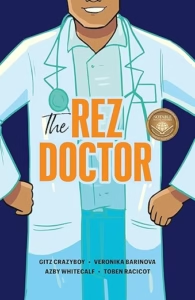The Rez Doctor
Gitz Crazyboy
Illustrated by Veronika Barinova
Coloring by Azby Whitecalf
Lettering by Toben Racicot
Highwater Press
Published September 10, 2024
Amazon | Bookshop | Goodreads
About The Rez Doctor
Young Ryan Fox gets good grades, but he’s not sure what he wants to be when he grows up. It isn’t until he meets a Blackfoot doctor during a school assembly that he starts to dream big.
However, becoming a doctor isn’t easy. University takes Ryan away from his family and the Siksikaitsitapi community, and without their support, he begins to struggle. Faced with more stress than he’s ever experienced, he turns to partying. Distracted from his responsibilities, his grades start to slip. His bills pile up. Getting into med school feels impossible. And now his beloved uncle is in jail. Can Ryan regain his footing to walk the path he saw so clearly as a boy?
This inspiring graphic novel for young adults is based on a true story.
My Review
I didn’t realize when I read this book that it was inspired by someone’s life. The story follows Ryan as he struggles in school, navigates growing up in a Native community, and becomes inspired to go to medical school and serve his people as a doctor. He faces challenges both in and out of school and college, and nearly gives up more than once. Ultimately, he finds his way through school and family life and leaves readers with an uplifting message about achieving one’s dreams.
The story does show some alcohol consumption and some harmful consequences. For example, Ryan’s uncle comes home drunk with his face bruised. Later, Ryan visits him in jail. In college, Ryan goes out drinking with friends and quickly discovers his grades suffer if he does this, so he quits. I think those scenes make it a little tricky to find the right reader age group. The length of the book will appeal to younger readers, but the content seems targeted more toward older readers.
All in all, this is an inspiring story that shows the importance of resilience and persistence. It’s a really short book– only about 60 pages– and written in graphic novel format, so it’s great for reluctant readers. I could see this being a useful aid for a social studies or career-focused school unit.
Content Notes
Recommended for Ages 14 up.
Profanity/Crude Language Content
One instance of mild profanity.
Romance/Sexual Content
One image shows a couple kissing. Another image shows a couple at a wedding.
Spiritual Content
Ryan asks tribal leaders and Creator for help.
Violent Content
A man comes home with a black eye and tells Ryan he was in a fight.
Drug Content
References to a family member drinking and getting into trouble (happens off-scene.) Ryan and his friends go out drinking. At one point, a friend offers him some pills.
Note: This post contains affiliate links, which do not cost you anything to use but help support this blog. I received a free copy of this book in exchange for my honest review. All opinions are my own.
